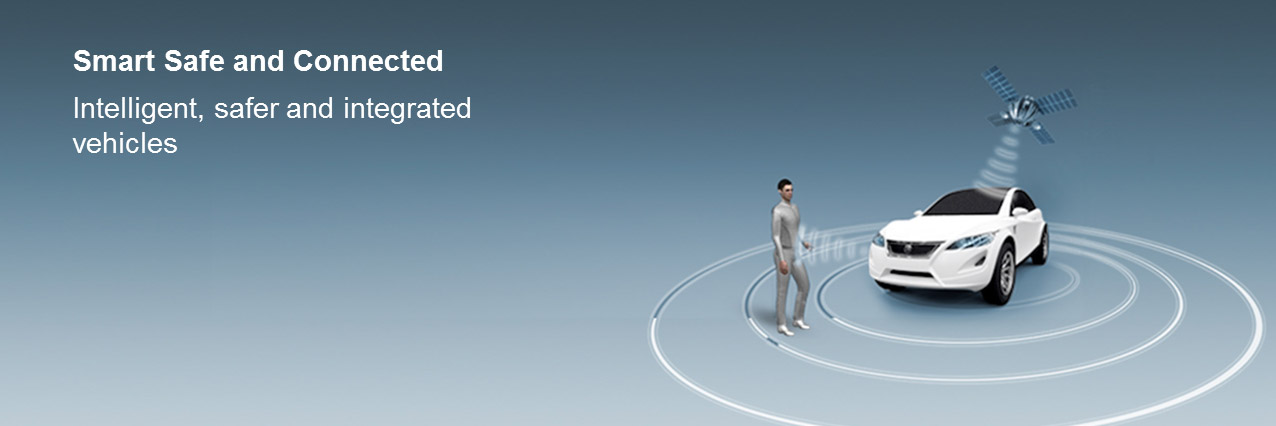The soul of tomorrow’s vehicle innovation originates from an intelligent core of embedded systems and electronics. But while advancing smarter vehicles, innovators must also manage complexity, optimise performance, and ensure vehicle safety. Transportation industry leaders rely on ‘Smart, Safe & Connected’ solutions from Dassault Systèmes to increase their competitiveness.

Smart Safe & Connected

Key Benefits
- Systems Definition and Performance Validation
- Embedded Electronic Architecture
- Embedded Software Development
- Electrical Engineering
- Electronic Engineering
- Integration, Test and Validation
- Functional Safety Delivery (ISO26262)
1. Systems Definition and Performance Validation
- Explore multiple iterations of system architecture faster and with greater accuracy.
- Re-use and integrate legacy models, leveraging MODELICA open language and Functional Mockup Interface (FMI) standard.
- Simulate and converge on the optimal mechatronic systems, ensuring performance & fulfilment of requirements.
- Improve product quality by capturing requirements, parameters and test cases which can then be traced against architecture, models and simulation results.
- Validate sub-systems and the entire digital vehicle earlier in development cycle, saving costs and minimising errors.
- Accelerate detection and resolution of potential systems performance issues or conflicts.
- Virtually detect performance errors at an early stage, before detailed design, reducing physical prototype costs.
2. Embedded Electronic Architecture
- Speed up productivity with a Model Based approach supporting development of embedded systems for functional, software and hardware architectures.
- Study alternatives and trade-offs to deliver new innovative customers functionalities faster.
- Manage traceability between all Embedded Electronic Architecture artefacts.
- Increase re-use of embedded electronic innovations across new vehicle programs.
- Automate specifications generation from models for Supplier Request for Information or Quotation.
3. Embedded Software Development
- Increase software re-use thanks to AUTOSAR methodologies.
- Strengthen productivity with automated models to AUTOSAR compliant code generation.
- Improve software quality with AUTOSAR conformance and tests.
- Smooth integration with current tools and processes, based on ARTOP open standard.
4. Electrical Engineering
- Enable systems development in a configured context, for better collaboration and efficiency.
- Ensure that electrical systems performance matches customer requirements.
- Explore multiple iterations of electrical systems faster and with greater accuracy.
- Virtually define electrical systems and automate physical 3D harness design, thereby minimising costly wire harness material and performance errors.
- Accelerate detection and resolution of potential electrical systems performance issues or conflicts.
5. Electronic Engineering
- Enable systems development in a configured context, for better collaboration and efficiency.
- Ensure that electrical systems performance matches customer requirements.
- Explore multiple iterations of electrical systems faster and with greater accuracy.
- Virtually define electrical systems and automate physical 3D harness design, thereby minimising costly wire harness material and performance errors.
- Accelerate detection and resolution of potential electrical systems performance issues or conflicts.
6. Mechatronic Engineering
- Multi-physics dynamic modeling and simulation, based on MODELICA language and libraries.
- Simulation coupling between multi-physics models and 3D Kinematics models.
- Optimise product design and run virtual test to meet customer needs, trace simulation results against initial requirements.
- Rapid development of systems comprising of mechanical, embedded control software and electronics.
- Minimise development cost and effort through the reuse of systems models.
- Ensure compliance with market and regulatory requirements through a structured Model Based Systems Engineering approach.
- Opened solution, leveraging MODELICA, FMI (Functional Mockup Interface), and Simulation and Tests connectors with external tools and applications.
7. Functional Safety Standard
- Minimise risk of warranty costs, recalls and corporate liabilities.
- Provide industry proven resources to ensure fulfilment of ISO 26262 safety requirements
- Automate reporting capabilities to satisfy functional safety standards/certification and fulfil critical deadlines
- Fulfil global/local industry standards, from requirements to final product validation, assuring end-to-end functional safety compliance
- Leverage integrated traceability capabilities, ensuring accountability.
Talk to one of our experts today!

